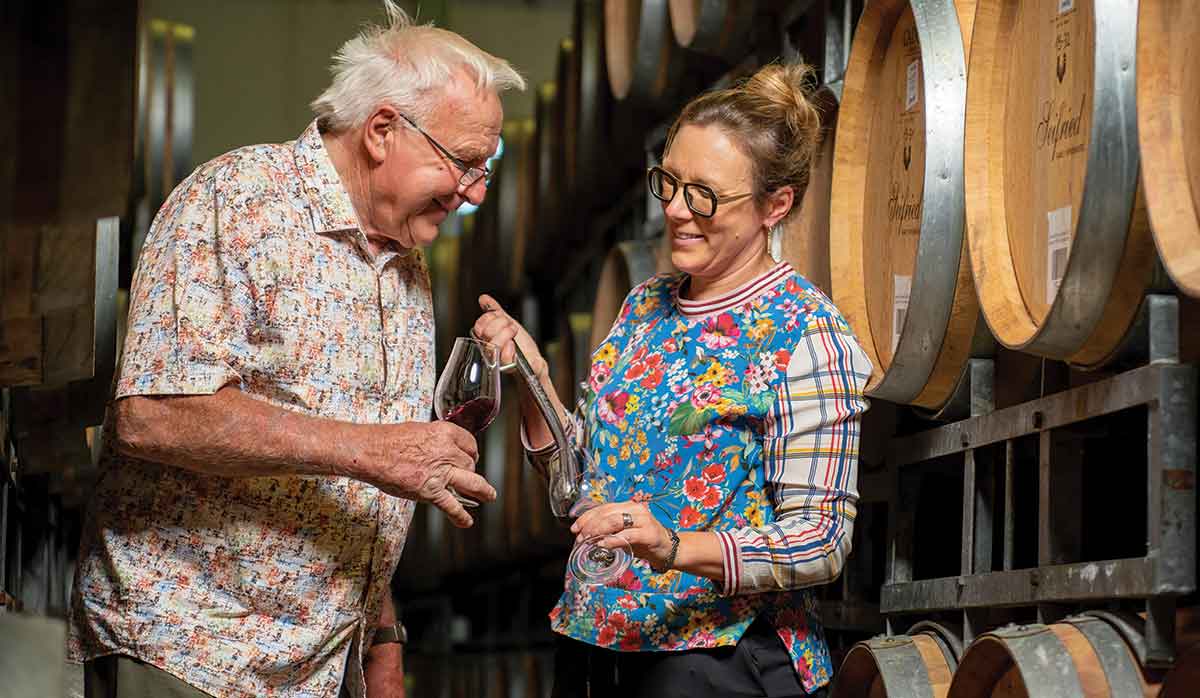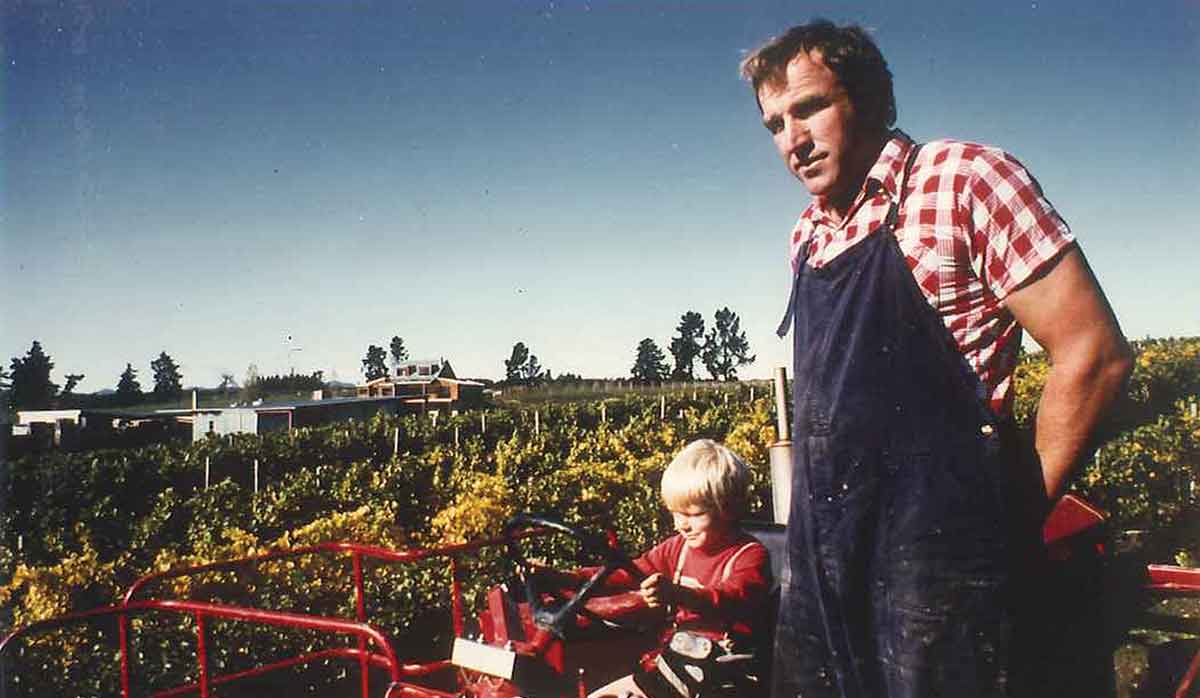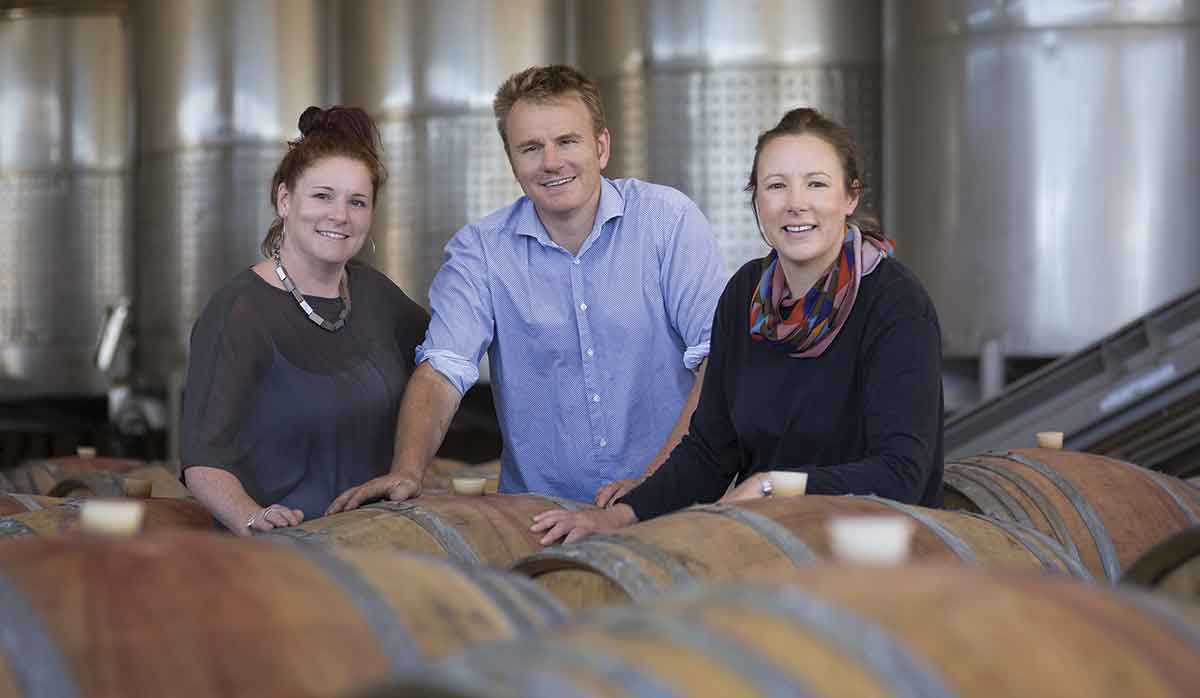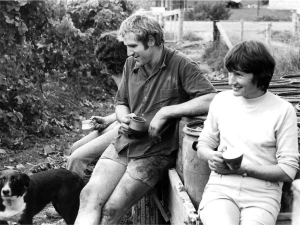As I sit down to write this piece in late January, my younger brother Chris is calling on my 11-year-old daughter for a helping hand. She is knocking around the winery at the end of her school holidays and he is dealing with a bottling line breakdown and needs a person with small hands to squeeze around the carton packer to unscrew bolts and take photos.
My childhood memories, and those of Chris and our sister Anna, are full of moments like this – waiting, helping or playing on the periphery while our parents Hermann and Agnes Seifried worked tirelessly to pioneer wine production in the Nelson region. In 1973 they hand grafted, planted and tended the region’s first commercial grapevines, and in 1976, 50 vintages ago this year, they harvested their first grapes.
Over the past five decades, our vineyards and winery have continued to expand, and today we own and run 10 blocks over 320 hectares, with an extensive varietal offering. Chris, Anna and I, having grown up in these vines, all work in the business our parents built from scratch, by hand, and against all expert advice.
A Romantic Dream
Our family wine story began on New Year’s Day, 1971, when Hermann arrived in New Zealand to become winemaker for the New Zealand Apple and Pear Board (NZAPB) in Nelson. In those days family producers in the North Island passed knowledge from generation to generation, with no formal wine education, so it’s quite possible Hermann was the first university-trained winemaker in the country.
He worked alongside Dr David Heatherbell (of DSIR in those days, and later Lincoln University), and was involved in several projects, including the development of Vivante, which is still ‘fondly’ recalled by many.
A few months after arriving, Hermann fell for a young secondary school teacher working as a home scientist at Nayland College. He met Agnes Wilkins, who hailed from a Southland sheep farm, at a summer work party on Mt Robert Ski Field in the Nelson Lakes, and they married in December that year.
 |
|---|
|
Hermann with Heidi |
Hermann has always regarded New Zealand as a place of opportunity. As one of six sons growing up in southern Austria, he understood that land supply is finite. When their father died at a relatively young age, Hermann’s oldest brother took over the operation, and Hermann accepted a scholarship to attend Staatliche Lehr- und Versuchsanstalt für Wein- und Obstbau Weinsberg. He was supported by the huge South African wine company KWV, and was bonded to work with them in Paarl for three years after graduating.
During his time in South Africa, Hermann became interested in other southern hemisphere wine producing countries, and says watching the Springboks take on the All Blacks cemented his interest in New Zealand. So when a visiting NZAPB group, investigating orchards and the making of apple wine, and they offered him a job to expand their beverage offering, he was in.
Once in the Nelson region, Hermann quickly realised the potential for winegrape production alongside the hops, tobacco and apples that grew so successfully here. But the ‘experts’ of the time considered it too cool and too far south to be viable, and government and rural bankers turned down their approaches for finance – there was simply no appetite to loan money to the crazy newlyweds who wanted to establish a wine business. They eventually found cautious support from the Anglican church, with a loan at close to 20% interest.
Agnes and Hermann purchased our original block in Upper Moutere, but kept their day jobs while removing the existing apple orchard in 1973. Grafting vines was not typical in New Zealand back then, but Hermann’s training had taught him that phylloxera would ultimately catch up with every wine region, so they spent late nights grafting vines (in seven different varieties) by hand. These days we grow and produce 13 varietals, giving us a valuable point of difference.
In 1996 they had their inaugural vintage, followed by successes at the National Wine Show, which boosted demand and sales just as they opened the Seifried Estate cellar door on Labour weekend that year.
The accolades gave my parents confidence in their wild dream and they continued a gradual vineyard expansion, highly motivated to repay the loan as soon as possible.
 |
|---|
|
Hermann and Chris |
In 1977 Hermann gave up his job and brought his full focus to vines and wines. My parents called on friends, neighbours and relatives to help with everything from concreting and laying blocks for the winery, to hand picking grapes.
A New Generation
As babies, Chris, Anna and I would sleep in our carrycots under the vines. As we grew up, we helped where we could, hand picking grapes, bird scaring on quad bikes, or with ratchets underneath strings of shimmering foil, once the seals on our glass milk bottles. Hermann was later involved in developing and trialling bird netting, before it was widely adopted by the industry. Back then, harvest ran from the very end of March to the first week of May. These days we pick our final grapes in the first week of April, which is an incredible shift in one generation.
In the winery we helped waterblast floors, watched tanks racking, and stood by pumps ready to press ‘stop’. Hermann had taught himself to weld, and spent late nights and early mornings repurposing old milk vats into upright wine tanks. We still have dozens of tanks he made, complete with a gutter rim where the early cooling system of the day would run cold water over the top of tanks and collect it for re-use. As kids we would help there too, dialing the gas bottles as Hermann moved along a stainless seam calling, “gas on; gas off”.
They set us up with a small stainless-steel bin, which was ideal for cooling off with a ‘swim’ on hot days. We would go on to make huts in cardboard boxes stacked up out the back of the cellar door, or have an afternoon kip, top-and-tailing on the couch outside the smoko room.
In the early years, Agnes would collect empty bottles from Jim at the Nelson tip at the end of her daily town run, delivering wine to local restaurants and hotels.
Seagulls circled and a cigarette hung from Jim’s mouth as he helped my mother load ‘empties’ into the back of the Hunter station wagon, working around my sleeping brother in his carrycot on the back seat. On rainy days, when vineyard work was off, our small team would work on the bottle washer in the winery to prepare the used bottles for the next bottling day.
Agnes also did a weekly exchange of a dozen bottles of wine with regular customers at our cellar door, as they returned their ‘empties’ for 10c refunds. These were the days before modern self-adhesive labels, and we kids rolled individual paper labels through the little ‘glue machine’.
 |
|---|
|
From left, Anna, Chris and Heidi. |
Other rainy-day tasks included assembling dividers ready for the next bottling run. It was a puzzle for new players, but we kids could quickly assemble the dozen bottle kit sets. We’d put capsules on corked bottles, hand stack bottles onto the machine, and help with packing. Perhaps my parents scheduled bottling during school holidays to capture willing helpers.
Meeting The Market
Our family business had a very loyal customer base, including people holidaying at Kaiteriteri and Golden Bay, who would visit each summer to reconnect with my mother at the cellar door. The Seifried kids would be around to assist with glass washing and restocking quickly depleted shelves.
Until we obtained a computer in the mid-1980s, Agnes maintained a database in multiple address books. She hand-addressed 4,500 envelopes three times a year at its peak (my siblings and I helped apply postage stamps) and sent out a newsletter and order form to encourage sales. The mail orders were dispatched daily with the Newman’s bus driver, who collected a pallet load on his way from Takaka to Nelson.
One of the things I genuinely appreciate, then and now, is the camaraderie in our industry, whether working alongside local Nelson producers or the wider New Zealand wine community. In the very early days, I recall Nelson-Marlborough industry wine tastings and picnics on Sundays, including one day in Pelorus in the 1980s, with producers from both sides of the hill meeting for a midway gathering. Some of those people are still in the industry today. Those strong connections were key when New Zealand wine was really gaining momentum overseas, particularly in the critical United Kingdom market, where they worked to build Brand New Zealand together.
We kids adapted to having extras in the car, as our family played tour guide to what seemed like an endless stream of internationals coming our way. I can vividly remember the day we took an Austrian hitchhiker named Rudi Bauer from the 1998 Cool Climate Conference in Auckland to his vintage job in Hawke’s Bay. Ultimately, he too put down roots, founding Quartz Reef in Central Otago.
Lifelong friendships also remain with many of our international distributors, customers and vintage crew. Agnes and Hermann take an annual trip with one of our earliest German vintage employees from the early 1980s, selecting a different wine region around the world to visit. My siblings and I have also kept contact with many of these people, and have employed second generation family vintage interns, which is a lovely full circle.
Half a Century On
We have been self-sufficient from the get-go, with no contract bottling lines or pruning crews back in the day. And we still manage every step in-house, from propagation, vineyard operations and staffing, through to bottling and distribution. That makes for a busy place with lots of diversity in day-to-day activities, but does mean we have close oversight of what goes into the bottle.
Chris, Anna and I all contribute in different ways, with Anna focused on sales and marketing, and overseeing our wonderful team of Pacific Islanders, part of the wider Seifried family since 2008. Chris takes charge of production and packaging, and the big picture generally. He also works closely with many of our overseas distribution partners in the United Kingdom and Europe. This leaves me as a bit of an allrounder. As well as working part time as a dentist, I lead the winery team with Chris, oversee the lab, quality control and compliance, and keep tabs on the vineyards as well.
Hermann still has massive love for growing grapes and coordinating the vineyard team, and makes sure we have the very best fruit the season has to offer come harvest time. While Agnes is rarely found at the office these days, she is on call when questions arise, offering a gentle listening ear, and is a wealth of knowledge, thanks to 50 years growing our business.
We have been fortunate to be a part of such a diverse and vibrant industry, characterised by its cohesive and supportive nature – just like a family really.












